Custom Airline Cleaning Scheduling Software – Revolutionizing Airport Efficiency
 2 January 2024
2 January 2024? Listen to the Summary of this article in Audio
The intricate world of airport operations is a beacon of activity where every second counts. The need for efficiency and precision in managing an airport’s diverse functions, especially the imperative cleaning and maintenance tasks, is at an all-time high. In response to this challenge, custom software development emerges as a transformative force, introducing innovative airline cleaning scheduling software that streamlines operations and propels airports into a new era of productivity. Central to this advancement is the Aviation Cleaning Software, a tailored solution adept at harmonizing the complexities of landside and airside management with the meticulous details of aircraft maintenance. By harnessing the power of an Airport Operational Database (AODB), such software enhances service quality and fosters precise planning, ensuring an immaculate and seamless passenger experience.
Moreover, the utilization of aircraft maintenance software further strengthens the ability to meet rigorous standards and optimizes not only the passenger’s journey but also the lifecycle of the aircraft themselves. By customizing these solutions, airports can dynamically update procedures and instantly communicate with all stakeholders, nurturing a well-coordinated environment ready to rise to the demands of modern air travel.
Key Takeaways
- Custom software development is key to optimizing airport efficiency and maintaining stringent cleanliness standards.
- Aviation Cleaning Software centralizes operations, from flight information management to the meticulous details of cleaning protocols.
- Real-time data integration through AODB plays a pivotal role in elevating service quality and meeting operational needs.
- Aircraft maintenance software is essential for the longevity and continual readiness of the fleet.
- Advanced software solutions enable airports to adapt and respond to changes in operations, promoting a resilient travel ecosystem.
The Essential Role of Cleaning in Airline Operations
Within the bustling world of aviation, cleanliness is paramount, far surpassing aesthetic considerations to become a core function tied intrinsically to an airline’s service quality and brand integrity. The introduction of aviation cleaning software into this realm signifies a major leap towards ensuring the meticulous upkeep of aircraft while upholding strict adherence to health and safety standards. The implementation of an airline cleaning solution is crucial—not only in fostering passenger confidence by providing a spotless and hygienic environment but also in championing compliance with regulatory mandates.
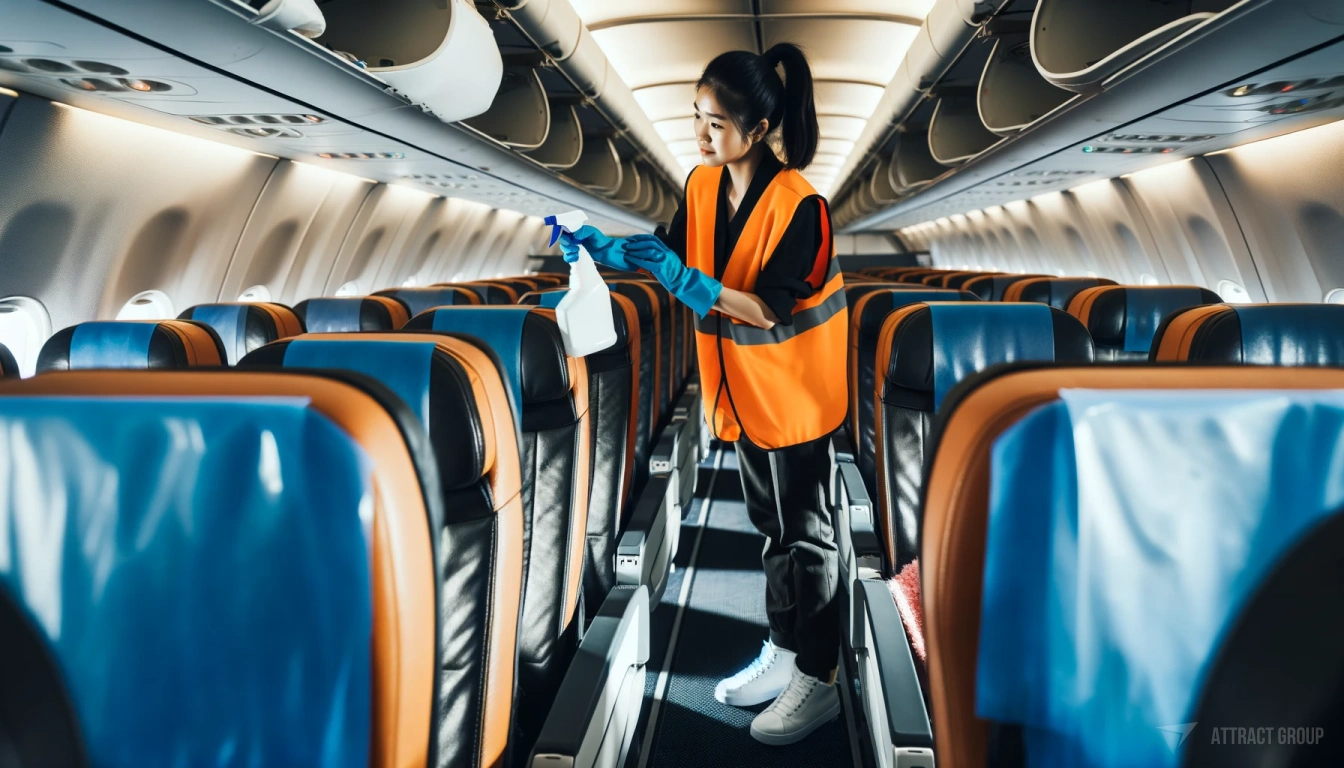
Amidst the unyielding pace of departures and arrivals, the need for an airport cleaning scheduling tool has never been more acute. This technologically advanced approach grants airlines the capability to master the high-frequency commitments of their flight schedules. The seamless execution of sanitation procedures, facilitated by robust scheduling tools, extends considerably in determining a flight’s readiness and punctuality—a reflection of an airline’s operational excellence. Thus, a focus on enhancing the cleaning discipline through specialized software solutions is both a strategic and necessary step for any forward-thinking airline.
“Ensuring each aircraft cabin is impeccably clean is not only about meeting customer expectations, it’s about exceeding them. It’s about safety, comfort, and the message it sends about who we are as an airline.”
The table below highlights the essential segments of airline operations benefitting from the deployment of comprehensive cleaning management systems:
| Operational Segment | Role of Cleaning Software | Impact on Airline Operations |
|---|---|---|
| Passenger Areas | Automates scheduling of deep cleaning and disinfecting procedures | Enhances passenger satisfaction and brand loyalty |
| Aircraft Cabins | Tracks cleaning tasks completion and standards compliance | Ensures safety and neatness, reducing risk of service disruptions |
| Baggage Handling | Coordinates cleaning team dispatch aligned with flight arrival and departure | Minimizes delays due to unclean conditions and creates a seamless baggage claim experience |
| Service Galleys | Monitors supply chain for cleaning materials and restocking needs | Keeps service areas hygienic, impacting onboard catering and amenities |
- Advanced Cleaning Standard Enforcement: A reliable cleaning solution ensures uniform application of cleanliness benchmarks across all aircraft, thereby maintaining high standards of hygiene wherever the airline operates.
- Scheduling Flexibility: Managing the unpredictable nature of aviation requires flexible scheduling to accommodate unscheduled maintenance or sudden increases in clean-up scale due to unexpected turnovers.
- Performance Analytics: Reporting capabilities within the cleaning software platform enable airlines to review operational performance and strive continually for improvements.
As the airline industry continues to adapt to the increasing demands of travel and the heightened expectations for cleanliness post-pandemic, the adoption of specialized aviation cleaning software embody a critical adaptation for maintaining a competitive edge. By offering a more agronomic allocation of time and resources, airline cleaning solutions represent a nexus between operational practicality and customer-centric service provided by the airlines.
Get a free consultation from our aviation software experts on optimizing your cleaning schedules and management.
Challenges in Airline Cleaning and Scheduling
The airline industry faces a constant battle against time and operational complexities. With passenger satisfaction hinging on the cleanliness and readiness of aircraft, managing these dynamic logistics can be daunting. The key tools that withstand this turbulence are the airline maintenance scheduling tool and the aircraft cleaning management system. These systems have become indispensable in juggling the detailed workload necessary to keep pace with the ever-evolving demands of air travel.
Managing a Dynamic and Detailed Workload
The intricate tapestry of aviation operations is rife with tasks that extend beyond the visible horizons of passenger services. Each day, an aviation scheduling software is put to the test, coordinating a blend of assignments ranging from the processing of passengers to the meticulous cleaning of aircraft interiors. The central puzzle involves maintaining a harmonious balance between a varied array of activities that, nonetheless, results in a singular outcome—a clean, safe, and welcoming environment for travelers.
Whether it’s scheduling the deep cleaning of cabins or managing the logistics of waste disposal, it’s the airport cleaning management system that ensures the strategies devised are not only drafted but also delivered with precision. This process includes:
- Real-time update capabilities for responding to instantaneous changes in conditions or requirements
- Adaptive scheduling to fit the shifting paradigms of aircraft time on ground (TOG)
- Efficient task allocation to cleaning crews based on flight timings and aircraft locations
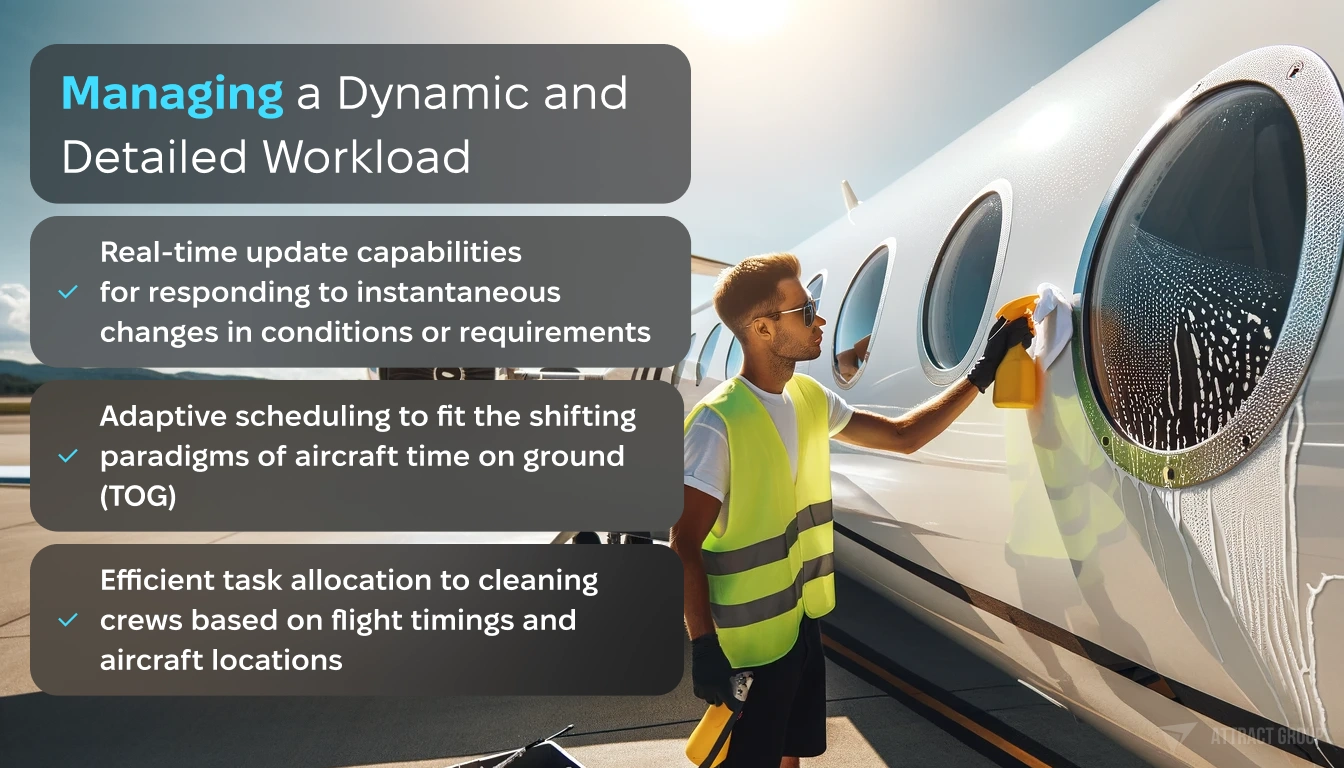
Adapting to High Volume and Tight Turnaround Times
In the ranks of airline operations, turnaround time reigns supreme. The window to clear remnants of one journey and prep for the next is narrow, placing considerable pressure on the cleaning teams. Here, efficiency isn’t merely a perk—it’s the lifeline that sustains the airline’s reputation. The airport cleaning management system shoulders this responsibility, ensuring that teams are deployed with clockwork precision, uniting behind the common goal of maintaining a fleet that’s ever-ready for takeoff.
“Optimal turnaround time is the invisible thread that stitches together the complex fabric of airline scheduling, making punctuality possible.”
The table below presents the interplay between the stringent demands placed upon airline cleaning protocols and the operational segments they affect:
| Airline Operational Segment | Function of Cleaning Software | Outcome for Airline Operations |
|---|---|---|
| Pre-Flight and Post-Flight Cleaning | Streamlines process mapping and checklists for each aircraft type | Guarantees compliance with health and safety standards for on-time departure |
| Deep Cleaning Schedules | Manages periodic in-depth cleaning sessions amidst busy flight operations | Extends aircraft service life and preserves passenger comfort levels |
| Emergency Cleanups | Provides quick response mechanisms for unforeseen incidents | Minimizes downtime and ensures operational elasticity |
| Crew and Supplies Coordination | Aligns cleaning staff shifts and restocks cleaning supplies as needed | Optimizes resource usage and mitigates risk of supply shortages |
Aligned with these challenges, the prowess of aviation scheduling software is benchmarked not just by the ability to plot a course through the daily operations but also by its resilience in navigating the unexpected—adapting, responding, and delivering against the clock and the crowd.
Let our team customize an aviation cleaning solution tailored to your unique operations and needs.
Benefits of Customizing Airline Cleaning Scheduling Software
With the ever-increasing pace of the aviation industry and the subsequent need for efficient operations, the move towards custom software development for airline maintenance is not just advantageous—it’s essential. Customized aircraft cleaning software underpins the aviation industry’s commitment to operation efficiency and a gleaming passenger experience. By tailoring software solutions to specific airline needs, airports can optimize every facet of their cleaning schedules, enhance communication, and secure that every resource is purposefully employed.
Increasing Efficiency in Operations
Efficiency is the heartbeat of airline operations. An aviation scheduling software tailored to the unique workflows of an airline can optimize workforce deployment, automate routine tasks, and promise the precise allocation of cleaning resources. The active synchronization of tasks and real-time data collection reduces turnaround times, amplifying overall productivity and preventing the domino effect of delays that compromise both schedules and service.
Creating a Seamless Travel Experience for Passengers
An enhanced passenger experience is the ultimate measure of an airline’s success. Integral to achieving this is an airline cleaning solution that ensures the impeccable state of aircraft cabins. As a result of customizing an airport cleaning scheduling tool, each task is efficiently planned and executed to the highest standards, directly impacting customer satisfaction. Mastery over the granular details that contribute to a seamless journey signifies exceptional brand service, from the cleanliness of the seating area to the maintenance and restocking of in-flight amenities.

“Maintaining a pristine and hygienic environment within the aircraft is pivotal not only for the safety of passengers but also as a reflection of the airline’s dedication to excellence.”
The table below illustrates the operational enhancements yielded by the adept implementation of cleaning scheduling software:
| Operational Enhancement | Description |
|---|---|
| Task Automation | Repetitive tasks, such as scheduling routine cleanings, are automated, reducing the likelihood of human error and freeing up staff for more complex duties. |
| Resource Allocation | Intelligent algorithms ensure that the optimal number of personnel is assigned to each job based on the size and turnaround requirement of the aircraft. |
| Real-time Updates | Flight statuses and cleaning progress are updated in real-time, ensuring any necessary adjustments are swiftly communicated and acted upon. |
| Data-Driven Decisions | Enhanced analytics offer insights into operational patterns, allowing for continual improvement in scheduling and resource management. |
By custom-building aircraft cleaning software, airlines can transform the complexity of operation schedules into streamlined, responsive plans that pivot on the axes of efficiency and service. In hand with the pivotal role that cleanliness plays in the airline industry, the benchmarks of operation—pre-emptive strategy, meticulous execution, and systematic progress—become embedded in the airline’s ethos.
- Boosts productivity by minimizing idle time and maximizing the use of every minute in the turnaround process.
- Enhances the ability to swiftly adapt to last-minute operational shifts or flight schedule changes.
- Provides passengers with the assurance of boarding a well-maintained aircraft, propelling customer trust and loyalty.
Ultimately, investing in custom aviation scheduling software solutions is not simply a matter of maintaining the status quo; it is a step into future-proofing airline operations where efficiency, safety, and an enhanced passenger experience reign supreme.
Key Features of Effective Airline Cleaning Scheduling Software
The efficiency of aviation operations hinges on a crucial yet often unheralded aspect: cleanliness. Airports and airlines rely on aviation cleaning software to achieve high standards of sanitation and maintenance. The difference between a good and an outstanding airline cleaning scheduling software lies in its features. Such software must facilitate precise coordination, comprehensive management, and real-time responses, all of which are critical for an operation with zero margin for error. Let’s explore the key functionalities that distinguish the most effective systems in the industry.
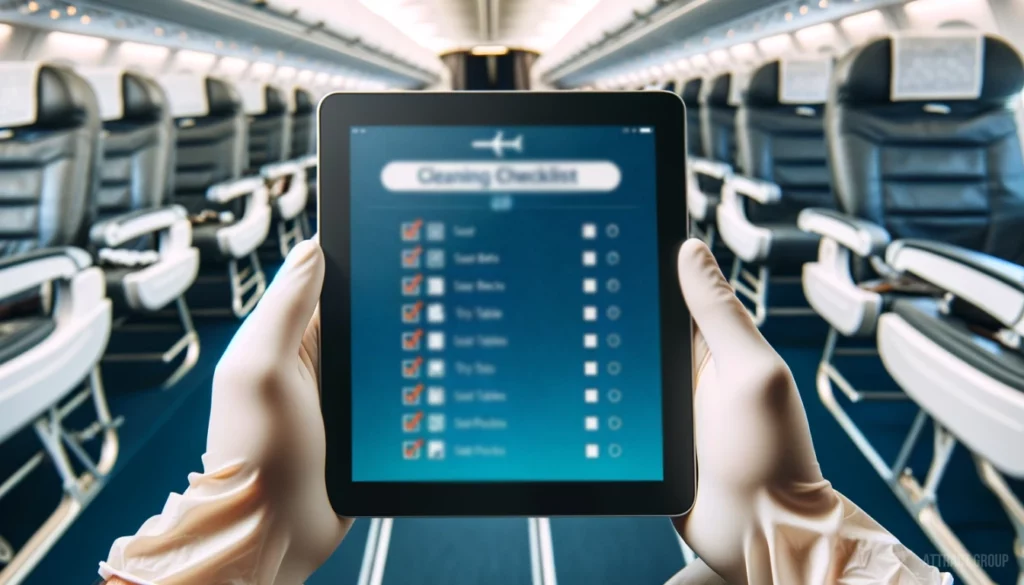
Real-Time Tracking and Updates
Top-tier aircraft maintenance software always includes real-time tracking capabilities, allowing immediate responses to the ever-changing landscape of airport operations. These systems provide up-to-the-minute updates on cleaning schedules, crew dispatches, and maintenance tasks, ensuring that each aircraft is ready for its next journey.
Seamless Integration With Existing Systems
A robust airport cleaning management system is not a standalone entity but one that integrates seamlessly with existing airport and airline infrastructure. This synergy is crucial for maintaining data coherence across the airport operational database (AODB), scheduling platforms, and resource allocation processes.
User-Friendly Interface and Mobile Accessibility
A user-friendly interface enhances accessibility for all personnel involved in keeping the airport in top condition. Adding mobile capabilities to this interface expands operational flexibility, ensuring that the necessary tasks can be coordinated and monitored from any location.
Detailed Reporting and Analytics
Facilitating informed decision-making with detailed reports on performance analytics and cleaning standards compliance is indispensable. Innovative software empowers airlines to continually assess and improve their cleaning operations’ efficiency and effectiveness.
Flexible Scheduling Options
Given the unpredictable nature of air travel, flexibility within cleaning schedules is a must-have feature. Effective airline cleaning software equips schedulers to adjust plans on the fly in response to delays, cancellations, or other unforeseen events.
Adaptive Response to Changes and Events
The best aviation cleaning software can swiftly adapt to internal and external events, ensuring that cleaning and maintenance jobs are re-scheduled as needed to prevent service interruptions or compromises in cleanliness.
“In aviation, the margin for delay is slim to none. It’s the reason why real-time updates and flexible responses are not just beneficial–they are critical features in our airline cleaning scheduling software.”
These features form the backbone of any high-performing cleaning management system within aviation. With these systems in place, airlines and airports can be confident in their ability to provide safe, clean, and comfortable experiences for passengers, crew, and staff alike. Below is a table summarizing the impact that these key features have on airline operations.
| Feature | Description | Impact on Airline Operations |
|---|---|---|
| Real-Time Tracking | Instant updates on cleaning schedules and status | Ensures efficiency and readiness of aircraft for departure |
| Integration With Systems | Compatibility with AODB and other operational software | Creates a cohesive management system for cleaning tasks |
| User-Friendly Interface | Easy-to-navigate software platforms | Allows swift adoption and reduces training requirements for staff |
| Mobile Accessibility | Software access on smartphones and tablets | Facilitates on-the-go management and decision-making |
| Reporting Tools | Insightful analytics and performance data | Assists in continual improvement of cleaning operations |
| Flexible Scheduling | Ability to adapt to unexpected changes and events | Minimizes disruptions and accommodates sudden operational shifts |
- Real-time tracking and scheduling ensure no aircraft is left behind due to cleanliness or maintenance issues.
- Integration with existing systems maximizes resource utilization and enhances time management.
- User-friendly and mobile accessible interfaces are essential for ease of use, especially for on-the-ground staff.
While several factors contribute to an airline’s success, maintaining a fleet of clean, sanitary, and well-maintained aircraft is foundational. It’s this underlying system of effective cleaning and maintenance, enabled by advanced scheduling software, that empowers an airline to soar above the rest.
Integrating Airline Cleaning Software with Existing Systems
The modern airport is a complex ecosystem where precision and harmonious system integration aren’t just expected, they’re imperative. In an age where efficiency equates to success, airlines are turning to custom software development to devise robust aircraft cleaning management systems. The key to unlocking the potential of these systems is their seamless integration with airport systems, corralling a unified front in the face of operational diversity.
The drive towards integration is not simply a quest for seamless operations; it’s foundational to the very nature of aviation software compatibility. Indeed, when the various components of an airline’s operational toolkit — from the AODB to the billing systems, from the operational control center to the ground crews — communicate flawlessly, efficiency isn’t just improved; it’s redefined.
Compatibility with Airport and Aircraft Systems
Meticulous integration efforts are vital for compatibility. Developers responsible for the design of aviation software applications must ensure that these tools not only meet today’s standards but also evolve alongside the technological advancements of the industry. Airport cleaning scheduling tools must nestle into the existing technological tapestry of airports, complementing and enhancing, rather than disrupting, the rhythmic flow of information.
Real-Time Data and Mobile Access for On-the-Go Management
The ability to adapt to a dynamic environment rests on the shoulders of real-time updates and mobile management. These two pillars stand as beacons of agility in an otherwise rigid structure, allowing for real-time decision-making and instantaneous response to changing operational needs.
Enabling management and ground staff to respond to alerts, adjust schedules, and communicate in an instant — from wherever they may be — isn’t a luxury; it’s becoming an industry standard.
Below is a table that encapsulates the synergistic benefits reaped from integrating a cleaning management system with the airport’s existing systems:
| System Feature | Benefit |
|---|---|
| Real-time Data Sharing | Immediate adjustments to cleaning schedules based on live flight data |
| Seamless System Integration | Unified platform for operations leading to synchronized workflow management |
| Mobile Accessibility | On-the-fly logistics management, enhancing team’s efficiency and adaptability |
| Data-driven Resource Management | Optimized allocation of staffing and equipment based on dynamic needs |
| User Interface Compatibility | Streamlined user experience reducing learning curve and response time |
Irrefutably, the cornerstone of effective airline cleaning software lies in its mastery over integration. With each element — from the granular level of individual tasks to the overarching management systems — playing its part, the complexity of airport operations can be conducted like a symphony, where each section complements the other, leading to a crescendo of streamlined operations and impeccable cleanliness.
Tackling Delays and Disruptions with Smart Scheduling
In the landscape of modern aviation, maintaining airline operational efficiency is paramount to success. Delays and disruptions, if not adeptly managed, can cascade through an airline’s flight schedule, causing a ripple effect of dissatisfaction and financial loss. Aviation scheduling software plays a critical role in preempting such outcomes, providing a robust foundation for smart scheduling systems to thrive.
These intelligent systems are designed to anticipate potential setbacks by analyzing extensive datasets that range from historical flight information to real-time operational statistics. Through the deployment of predictive analytics, airlines can identify the most common causes of delays and strategically adjust their operations, thus significantly reducing the likelihood of disruptions.
Anticipating and Managing Common Causes of Delays
Predictive models within aviation scheduling software use machine learning algorithms to spot trends and trigger alerts when delay-inducing patterns arise. This proactive stance enables airlines to manage these common causes of delays:
- Aircraft maintenance and servicing requirements
- Turnaround time optimization for incoming flights
- Adverse weather conditions and air traffic congestion predictions
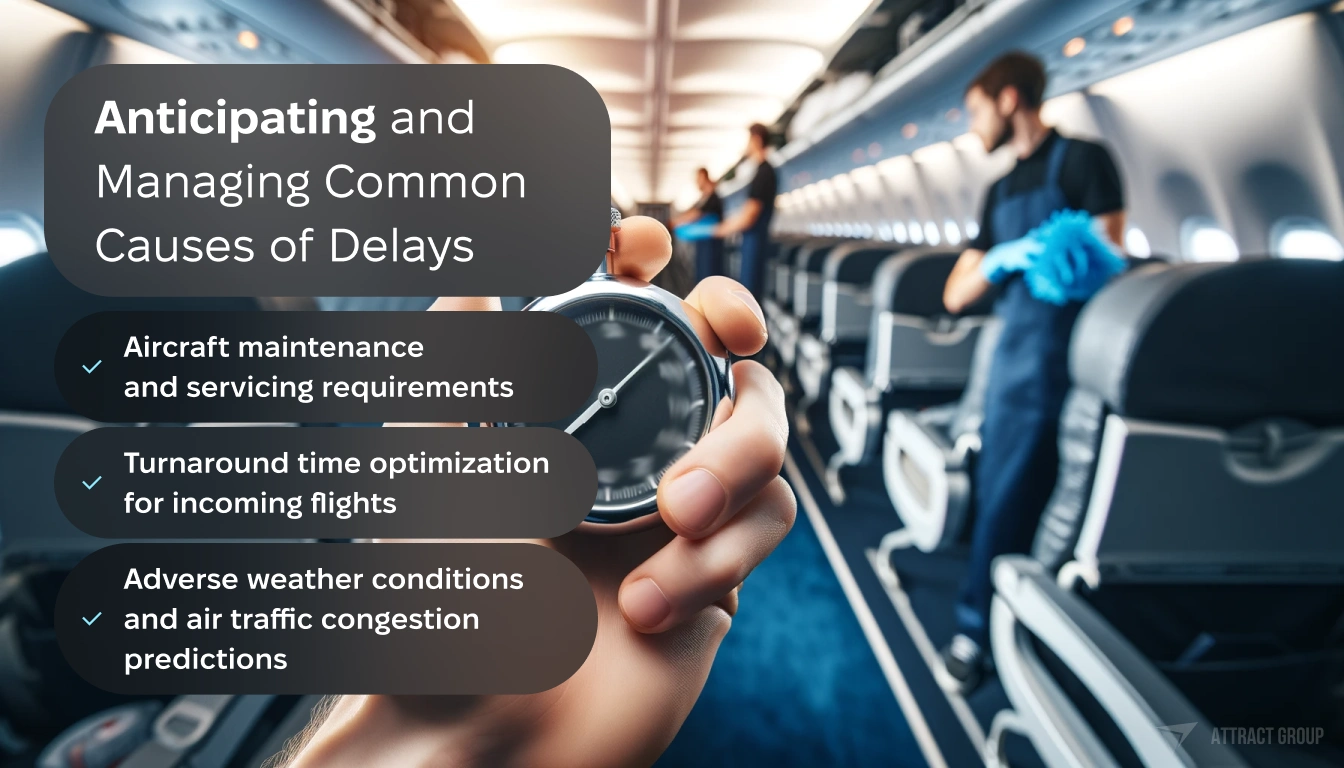
The following table further illustrates how incorporating smart scheduling systems can enhance key aspects of flight operations and preempt common delay scenarios:
| Aspect of Flight Operations | Role of Smart Scheduling | Benefit |
|---|---|---|
| Aircraft Availability | Optimizes maintenance schedules to align with flight rotations | Reduces ground time and increases service availability |
| Crew Management | Anticipates crew availability based on rest requirements and travel restrictions | Prevents crew-related delays and adheres to labor regulations |
| Passenger Processing | Forecasts peak times and aligns staffing levels accordingly | Streamlines check-in and security, enhancing passenger flow |
| Resource Allocation | Dynamic adjustment in response to operational fluctuations | Ensures efficient use of gates, lounges, and other facilities |
“By leveraging aviation scheduling software, we have been able to anticipate potential disruptions and mitigate their impact, ensuring a seamless experience for our customers and maintaining our schedule integrity.”
In the quest to attain and sustain peak operational efficiency, smart scheduling systems offer airlines a strategic advantage. These systems not only improve an airline’s adaptability to unpredictable events but also secure the vital trust and satisfaction of passengers. By leveraging the latest in technological advancements, these tools are essential in the ongoing efforts to transcend the traditional limitations of airline operations and navigate the complexities of the modern airspace.
Improving Aircraft Turnaround Times through Streamlined Scheduling
Efficient aircraft turnaround is a cornerstone of airline operations, crucial for reducing ground time and maximizing flight availability. The enhanced use of an airline maintenance scheduling tool proves to be transformative, bridging the gap between operational readiness and the tight timelines that define airport logistics. Streamlined scheduling is key in improving aircraft turnaround efficiency, which in turn positively affects the overall performance of airlines globally.

Enhanced Communication Among Ground Crews and Management
One of the most significant benefits of streamlined scheduling software is the dramatic improvement it brings to ground crew communication. By ensuring all parties are on the same page with real-time updates, management and ground crews can work in a harmonious symphony of efficiency and precision. The direct result of improved communication is a noticeable leap forward in minimizing delays, thereby upholding the stringent schedules critical to airline success.
Effective communication within the aircraft turnaround process is vital — it can mean the difference between an on-time departure and unexpected delays that ripple through the day’s schedule.
Let’s delve into the specific ways through which an advanced airline maintenance scheduling tool enhances teamwork and cooperation among airport staff:
| Key Feature | Function | Impact on Turnaround Efficiency |
|---|---|---|
| Real-Time Updates | Allows for instant communication of any changes in schedule or task assignments. | Ensures ground crews are always working with the most current information, reducing response times and errors. |
| Task Allocation System | Automatically assigns tasks to crew members based on expertise and location. | Optimizes workforce distribution, leading to accelerated completion of maintenance and preparation tasks. |
| Integrated Communication Platforms | Enables swift messaging and updates between various teams and management. | Facilitates coordination among different teams, reducing misunderstandings and improving overall response to changes. |
| Performance Tracking | Monitors the duration of each task and crew’s performance. | Allows for data-driven enhancements to the scheduling process to further increase efficiency. |
| Mobile Accessibility | Provides access to scheduling tools on various devices, enabling management on the move. | Aids in quick decision-making and action, essential for the fast-paced airport environment. |
- Customization options ensure that software can be tailored to suit the specific needs of each airport’s setup.
- Automated reminders and checklists prevent any steps from being overlooked during the cleaning and preparation stages.
- Hands-off dispatch systems for ground crews reduce time spent on organization, enabling more time on execution.
Meticulous scheduling enhanced by thorough communication tools is an irreplaceable asset in the aviation industry’s pursuit of punctuality and reliability. The effects are felt not just on the ground – where every minute counts – but also in the air, where passengers’ satisfaction and airlines’ reputations soar on the wings of efficiency.
Our experts can develop custom scheduling software to optimize aircraft maintenance and ground operations.
Custom Software vs. Off-the-Shelf Solutions: What to Choose?
In the complex and fast-paced world of aviation operations, finding the right balance between cost, efficiency, and customization is critical for success. Airlines are often faced with the decision of adopting off-the-shelf solutions or investing in custom software development. Each approach has its unique advantages and challenges.
Off-the-shelf solutions offer a quick and typically less expensive start. These packages come ready-made, often designed with a broad user base in mind, ensuring that a wide range of general functions are covered. However, the one-size-fits-all nature can be limiting for airlines with specific, detailed operational needs, such as airline cleaning scheduling software.
On the other hand, custom software development provides tailored solutions. Capabilities like aviation software customization allow airlines to focus on specific challenges, such as detailed flight turnaround timelines, integration with existing systems, and real-time updates necessary for keeping pace with the dynamic nature of airline operations.
Opting for customization in software solutions empowers airlines with the agility to adapt services precisely for their operational model and customer needs.
When contemplating custom software development vs. off-the-shelf solutions, several key factors must be carefully weighed to ensure the best fit for airline operations:
| Consideration | Custom Software | Off-the-Shelf Solutions |
|---|---|---|
| Specificity of Needs | Highly tailored to unique operational requirements | Generic functions that may not cover all specifics |
| Scalability | Designed to grow and adapt with the airline’s needs | May lack the flexibility to scale effectively |
| Integration Capabilities | Easier to integrate with existing systems and workflows | Potential for integration issues |
| Long-term Costs | Potential higher upfront costs but more economical in the long run | Less upfront cost but can require additional expenditure for customizing or scaling |
While selecting the best software solution is far from trivial, investing in custom software development often offers longer-term benefits for airlines that prioritize flexibility, efficiency, and staying ahead in a competitive market. A fine example of this approach is custom-built airline cleaning scheduling software, which allows for streamlined management of cleaning crews, resources, and schedules, thus maintaining pristine conditions of aircraft and ensuring timely departures.
- Customization offers a precise fit for airlines’ unique processes, improving overall operational effectiveness.
- Longevity and scalability are inherent with custom solutions, ensuring the airline’s ability to adapt to changing market conditions and regulations.
- Long-term cost savings are realized through increased efficiency, fewer requirements for add-ons, and less need for external support.
Ultimately, the choice between custom and off-the-shelf will hinge on the airline’s specific operational requirements, growth plans, and readiness to invest in a solution that will evolve in tandem with their business.
Real-World Success Stories: Airlines Thriving with Custom Scheduling Software
The evolution of the aviation industry has been significant, with the rise of custom scheduling software standing out as a pivotal development. Exemplified by various success stories across the globe, airlines are harnessing the power of advanced airline cleaning solutions to streamline operations, diminish delays, and amplify passenger satisfaction. These case studies highlight the profound impact that tailored software has on maintaining the standards of productivity and efficiency in the fast-paced aviation environment.
From reducing ground time to ensuring aircraft cabins are pristine, custom scheduling software has become a touchstone for operational excellence. When cleaner planes take off on schedule, airlines not only adhere to rigorous health standards but also solidify their reputation among travelers. This alignment is showcased in the detailed case studies that follow, where airlines have integrated these solutions to overcome unique challenges and set new benchmarks for success.
“By leveraging custom scheduling software, we’ve seen a drastic reduction in turnaround times, which directly correlates to our ability to increase flight frequency and maintain competitive pricing.”
- An airline noted for pioneering in-flight experience enhancements employed a bespoke aviation cleaning software to automate their cabin service schedules. As a result, passenger satisfaction scores have seen a steady increase.
- A renowned carrier successfully integrated a mobile-enabled airline cleaning solution that provided real-time updates to ground crews, leading to a 25% improvement in on-time departures.
- Implementing scalable and flexible cleaning modules, another airline was able to adjust to seasonal demands without compromising on service quality, a testament to the malleability of custom software.
Offering a deeper dive into the operational advantages achieved by airlines, the following table illustrates the performance metrics before and after the adoption of custom scheduling software:
| Airline | Pre-Software Implementation | Post-Software Implementation | Overall Impact |
|---|---|---|---|
| Alpha Airways | 60% on-time departure rate | 85% on-time departure rate | Reduction of delays and increased flight frequency |
| Bravo Airlines | 40-minute average turnaround time | 25-minute average turnaround time | Enhanced ground operations efficiency |
| Charlie Carrier | 75% customer satisfaction index | 90% customer satisfaction index | Improved passenger perception of cabin cleanliness |
These aviation industry case studies demonstrate that the strategic application of custom scheduling software enables airlines to meet and exceed the challenges of maintaining high hygiene standards. Not only does this approach support an optimal travel experience, but it also serves as a competitive differentiator in an industry where customer loyalty is heavily contingent on service quality. As these success stories underscore, investing in innovative cleaning and scheduling solutions pays dividends in both operational agility and customer satisfaction.
Keeping Up with Regulatory Compliance through Automation
In the complex realm of aviation, maintaining airline regulatory compliance is a critical and challenging aspect of day-to-day operations. As regulators worldwide continue to enhance safety standards in airline operations, airlines must adapt rapidly to remain compliant. Automation plays a crucial role in this adaptation, particularly through the use of custom cleaning scheduling software. Such software streamlines the compliance process by automating data recording and operations related to automated aviation cleaning, which are essential for upholding safety regulations and passenger trust.
Adhering to Safety Standards and Cleaning Regulations
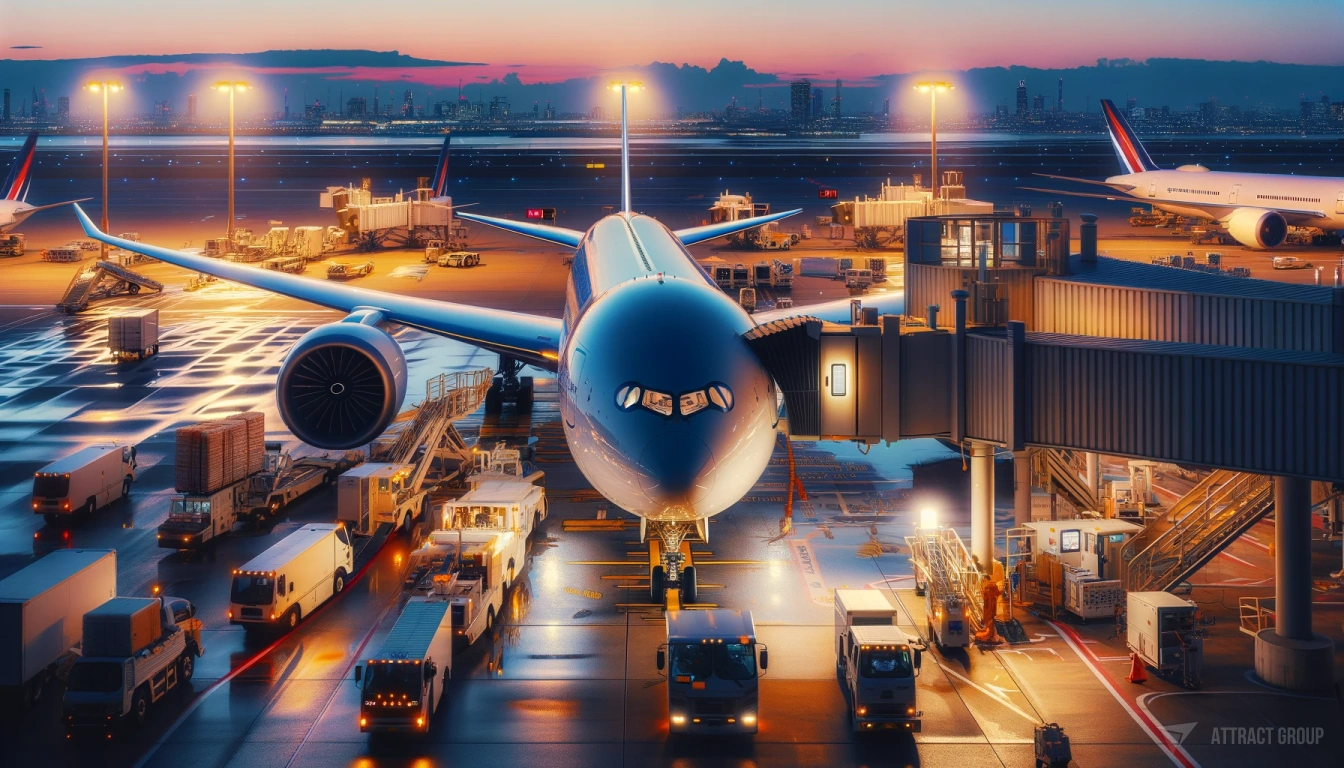
Airlines are mandated to follow rigorous safety protocols, which include strict cleaning standards to ensure the health and wellbeing of passengers and staff. Automated systems facilitate adherence to these standards by providing a framework for precise scheduling, monitoring, and verifying the implementation of cleaning operations. This technological intervention is not only about maintaining a clean aesthetic; it ensures airtight compliance with international and domestic health regulations.
Comprehensive compliance is no longer a function of manual checks; it is the domain of advanced software solutions that keep airlines at the forefront of safety and cleanliness.
The transition to automated solutions empowers airlines to generate accurate compliance reports effortlessly, thereby simplifying the audit processes and reducing the risk of human error. Moreover, these automated systems can be continuously updated to reflect the latest regulatory changes, thereby enabling quick adaptation to new rules.
| Regulatory Area | Automated Solutions | Benefits of Automation |
|---|---|---|
| Cabin Cleanliness | Systematic deployment of cleaning crews | Consistent compliance with health and hygiene regulations |
| Data Recording | Electronic logs of cleaning operations | Complete and accurate data for regulatory review |
| Standards Adherence | Regular updates to match evolving regulations | Immediate conformity to new safety standards |
Automated solutions not only enable airlines to adhere to regulations but also do so in a manner that optimises time and resources. By forecasting and scheduling cleaning needs in alignment with flight operations, these systems ensure a well-orchestrated harmony between efficiency and compliance.
- Automated compliance tracking ensures each aircraft meets health and safety requirements before takeoff.
- Rapid scalability of automated systems allows for quick adjustments when regulatory guidelines are updated.
- Enhanced record-keeping assures a transparent and verifiable track of compliance efforts.
Embracing automation is not merely a strategic move; it’s a necessary pivot as the airline industry continues to evolve. For airlines, the integration of automated aviation cleaning systems signifies a steadfast commitment to safety, passenger satisfaction, and operational integrity.
How Technology is Shaping the Future of Airline Cleaning Operations
The advent of technology, particularly AI in aviation, has begun to significantly influence the methodology and efficiency of airline cleaning operations. By implementing predictive scheduling through ML, airlines can forecast operational needs with precision, enabling the allocation of cleaning resources before issues manifest. This forward-thinking approach is made possible as data-driven airline management systems leverage advanced analytics in aviation to optimize every facet of the operation, from staffing to equipment deployment.
Incorporating AI and ML for Predictive Scheduling
Through the integration of artificial intelligence, and more specifically, machine learning algorithms, aviation industry stakeholders can now practice predictive scheduling. This bold move towards embracing AI in aviation enables a significant reduction in downtime and ensures the timely turnover of aircraft, critical for maintaining a competitive edge in the industry. ML uses historical and real-time data to anticipate when and where cleaning crews will be needed, therefore streamlining the entire process with impressive accuracy.
Predictive scheduling through ML is transforming the landscape of airline operations, affording a proactive stance in managing the perpetual cycle of aircraft cleaning and readiness.
- Utilization of AI for forecasting cleaning crew needs and planning service schedules.
- ML algorithms identify patterns in turnaround times, facilitating just-in-time cleaning crew dispatch.
- Intelligent systems suggest optimal times for deep cleaning, based on predictive passenger flow models.
Utilizing Advanced Analytics for Operational Insights
Advanced analytics in aviation are invaluable in the relentless pursuit of operational excellence. By sifting through extensive data, these systems provide insights that would otherwise remain hidden to human analysis. Technology in airline cleaning has adopted these analytics to refine processes, which in turn reduces waste and boosts efficiency across the board.
| Operational Factor | Role of Advanced Analytics | Resulting Benefit |
|---|---|---|
| Cleaning Crew Efficiency | Analyzes performance data to optimize crew sizes and allocation | Maximized productivity of the operational workforce |
| Supply Chain Optimization | Tracks inventory levels and predicts reordering times | Ensures continuous availability of cleaning supplies, eliminating downtime |
| Customer Satisfaction Levels | Monitors feedback related to cleanliness to enhance procedures | Directly responds to passenger needs, improving brand loyalty |
The future of technology in airline cleaning operations points towards an increasingly predictive and autonomous system, one that seamlessly blends AI-inspired predictions with rigorous, data-backed operational insights. The outcome is a cleaning paradigm that not only meets but often exceeds the high standards passengers have come to expect.
Conclusion: Streamlining Skies with Smarter Solutions
The aviation industry stands on the cusp of a sweeping transformation, with the integration of custom software redefining the framework of airline operations. As this article has explored, the utilization of tailored airline cleaning scheduling software serves as a beacon of aviation industry innovation, heralding a future where efficiency and precision are not merely goals but constants within the sphere of air travel. The benefits of custom software extend beyond mere functionality, offering the power to optimize airline operations by addressing the unique challenges of each airline, ensuring a cleaner, safer, and more satisfying passenger experience.
In an era where travel demands continue to escalate, the custom software benefits emerge as a crucial differentiator for airlines. The development and application of such bespoke solutions equip carriers with the agility to adapt to an ever-changing landscape, scale according to demand, and exceed regulatory compliances with ease. By embracing the future of aviation cleaning, airlines are not only elevating their operational prowess but are also reinforcing their commitment to passenger well-being and environmental stewardship.
As we have seen, technology is the linchpin of progress in aviation, and its permeation into cleaning operations is a testament to the sector’s forward-thinking ethos. From AI and ML predictive scheduling to advanced analytics for resource management, this digital revolution within the aviation industry sets a high bar for service delivery and operational robustness. For the discerning airline that seeks to surpass the competition and lead into the future, investing in custom cleaning scheduling software is not just smart—it’s essential for continued relevance in a world that insists on excellence at every altitude.
Let our team help build you custom aviation software tailored for your unique needs and improved efficiency.
FAQ
What is airline cleaning scheduling software?
Airline cleaning scheduling software is a specialized solution designed to streamline the organization and management of cleaning tasks for aircraft. It helps airlines optimize cleaning schedules, manage workloads, comply with health and safety standards, and ensure a high level of cleanliness for their fleets.
How does aviation cleaning software contribute to airline operations?
Aviation cleaning software plays a critical role in airline operations by ensuring aircraft are cleaned efficiently and ready for passenger boarding, improving brand image, and fulfilling health and safety regulations. It also provides real-time updates and enhances communication, which is vital for quick turnaround times.
What are the challenges in managing airline cleaning and scheduling?
Challenges include handling dynamic workloads, adapting to varying passenger volumes, meeting tight schedules for aircraft turnaround, and maintaining high cleanliness standards under operational pressures. Effective management requires flexible, precise, and real-time response capabilities.
Why should airlines customize their cleaning scheduling software?
Customizing cleaning scheduling software allows airlines to automate routine tasks, optimize resource allocation, improve communication, and ensure efficiency and accuracy in cleaning operations. Tailor-made solutions can better accommodate specific operational needs and help maintain punctuality and service quality.
What are the key features of effective airline cleaning scheduling software?
Effective scheduling software should include real-time tracking, seamless integration with existing systems, user-friendly interfaces, mobile accessibility, flexible scheduling options, and advanced reporting tools. Predictive analytics and AI support are also valuable for anticipating operational demands.
How important is system integration for aircraft cleaning management?
Integration is crucial for coordinating and streamlining cleaning operations. It ensures that all relevant data and updates are shared seamlessly between airline scheduling systems, maintenance systems, and airport operational databases, resulting in more synchronized and efficient cleaning processes.
How can smart scheduling help manage airline delays and disruptions?
Smart scheduling with predictive analytics allows airlines to anticipate and mitigate potential causes of delays. By using historical data and operational metrics, airlines can adjust cleaning schedules proactively to maintain punctuality and reduce the impact of disruptions.
What strategies improve aircraft turnaround times via streamlined scheduling?
Strategies to improve aircraft turnaround include enhanced communication between ground crews and management, quick coordination for task handoffs, and efficient resource deployment. Streamlined scheduling can significantly reduce waiting times and increase operational readiness.
When should an airline consider custom software over off-the-shelf solutions?
An airline should consider custom software when it requires tailored solutions that can adapt to their specific operations, offer integration capabilities with their existing systems, and scale with future growth. While off-the-shelf solutions can be effective for general needs, custom software provides long-term benefits aligned with unique airline processes.
Can you provide some examples of successful airline cleaning operations with custom software?
Success stories typically involve airlines that have utilized custom scheduling software to improve the effectiveness of their operations. These airlines report better management of cleaning tasks, reductions in delays, enhanced passenger satisfaction, and efficient use of resources, often leading to cost savings and operational excellence.
How does automation support regulatory compliance in aviation cleaning?
Automation through custom software aids in maintaining and demonstrating regulatory compliance by accurately tracking cleaning processes, maintaining detailed records for audits, and ensuring consistent adherence to safety standards and cleaning regulations.
What technological advancements are shaping the future of airline cleaning operations?
Advancements such as AI and ML are enabling predictive scheduling, which improves forecasting and resource allocation. Advanced analytics provide deep operational insights that facilitate data-driven decision-making. Such technologies are integral to enhancing the efficiency and effectiveness of airline cleaning operations.









